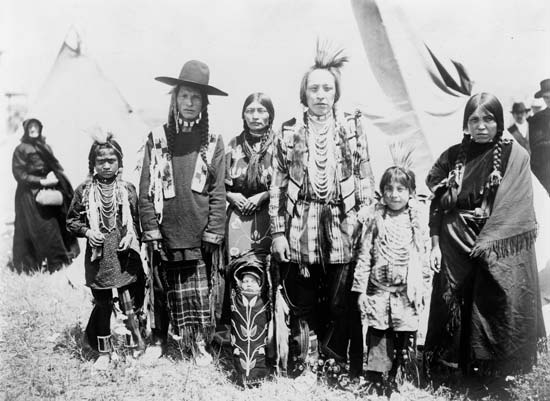Kutenai
people
also spelled Kootenay
 North American Indian tribe that traditionally lived in what are now southeastern British Columbia, northern Idaho, and northwestern Montana. Their language is of uncertain classification, some authorities placing it in the Wakashan family and some classifying it independently. The tribe is thought to be descended from an ancient Blackfoot group that migrated westward from the Great Plains to the drainage of the Kootenai River, a tributary of the upper Columbia. Plentiful streams and lakes, adequate rainfall, and abundant game and fish made this area the most favourable part of the plateau between the Rockies and the Pacific Coast Ranges.
North American Indian tribe that traditionally lived in what are now southeastern British Columbia, northern Idaho, and northwestern Montana. Their language is of uncertain classification, some authorities placing it in the Wakashan family and some classifying it independently. The tribe is thought to be descended from an ancient Blackfoot group that migrated westward from the Great Plains to the drainage of the Kootenai River, a tributary of the upper Columbia. Plentiful streams and lakes, adequate rainfall, and abundant game and fish made this area the most favourable part of the plateau between the Rockies and the Pacific Coast Ranges.Kutenai culture combines some traits of the Plains Indians (Plains Indian) with others of the Plateau Indians (Plateau Indian). After acquiring horses, they engaged in annual bison hunts beyond the Rockies and into the Plains. The advent of horse transport also increased the importance and frequency of military activities; formalized war honours became a means of social advancement, and increasing numbers of war captives (women and children, mostly Blackfoot) made slavery, adoption, and intermarriage more common. The Kutenai dressed in clothing made of antelope, deer, or buffalo hide (breechcloths for men, tunics for women), lived in conical tepees, and painted their garments, tents, and bodies much in the manner of the Plains tribes. Like other Plateau peoples, however, they engaged in communal fishing, built great bark and dugout canoes, and acknowledged a supreme chief only when undertaking special expeditions.
Among the Kutenai there were no clans, classes, or secret societies; they were divided loosely into bands, each with a nominal leader and an informal council of elders. They deified the sun and, like most other indigenous North American peoples, practiced animism, the belief that a multitude of spirits pervades all things in nature. shamanism also had considerable influence within Kutenai culture.
Early 21st-century population estimates indicated more than 5,000 individuals of Kutenai descent.
- William H McNeill
- William Hogarth
- William Holabird
- William Holden
- William Holman Hunt
- William Holmes McGuffey
- William Hone
- William Hooker Gillette
- William Howard Taft
- William Howard Taft: Defense of a High Tariff
- William Howard Taft: Inaugural Address
- William Howard Taft: Limited Presidential Power
- William Howard Taft: The Cabinet and the Congress
- William Howe
- William Howe, 5th Viscount Howe
- William Howe Howe, 5th Viscount
- William H Seward
- William H. Stein
- William Hull
- González, Julio
- González, Manuel
- González Martínez, Enrique
- González Márquez, Felipe
- Gonçalves, António Aurélio
- Gonçalves Dias, Antônio